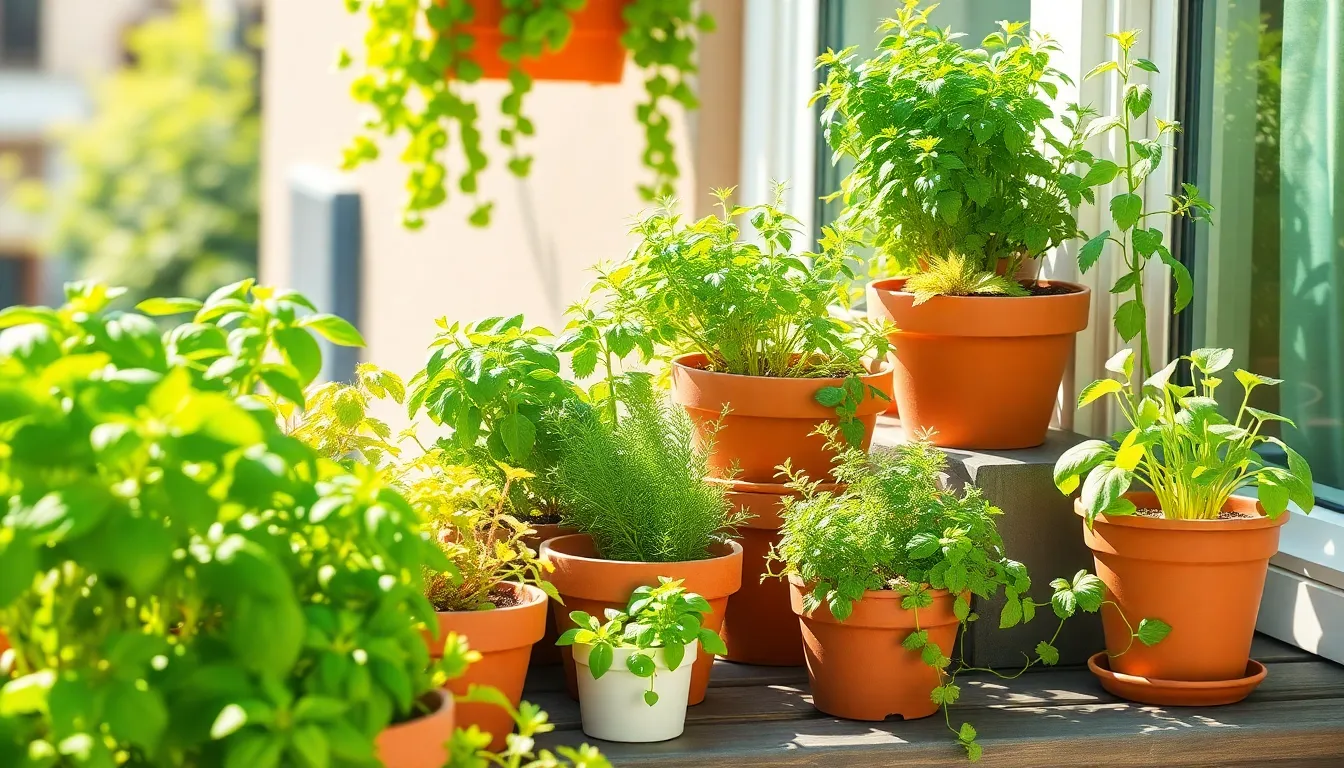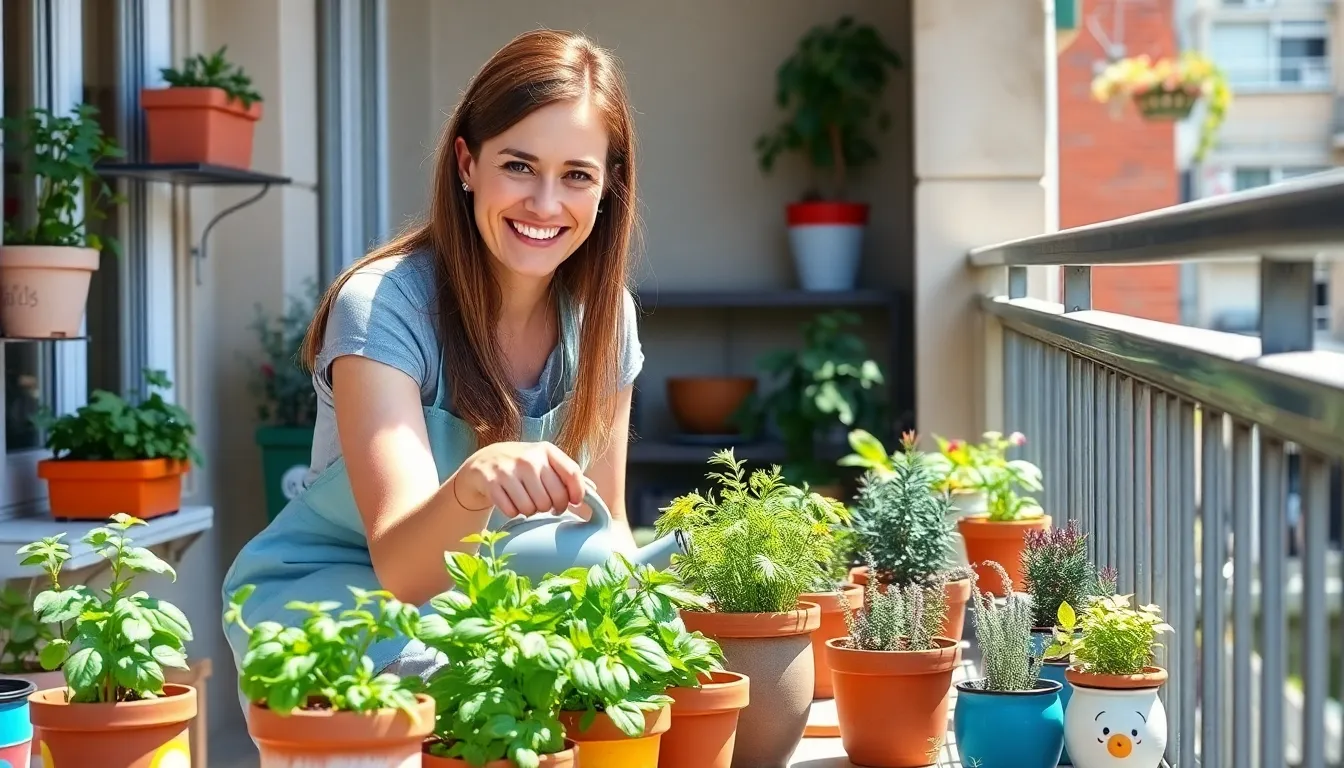Imagine stepping outside to snip fresh basil for your pasta or plucking mint leaves for a refreshing cocktail. Herb container gardening transforms any small space into a flavorful paradise. Whether it’s a sunny balcony or a cozy kitchen windowsill, growing herbs in containers is not just practical; it’s downright delightful.
With a little creativity and some quirky pots, anyone can become a green-thumbed culinary wizard. From vibrant thyme to aromatic rosemary, the possibilities are endless. Plus, it’s a fantastic way to impress friends with your gardening prowess—who knew you could be a master gardener while still wearing your pajamas? Dive into these herb container gardening ideas and discover how easy it is to cultivate a mini herb haven that’ll elevate your dishes and your mood.
Table of Contents
ToggleUnderstanding Herb Container Gardening
Herb container gardening involves cultivating herbs in small, portable containers. This method suits various spaces, including balconies, patios, and kitchens. To start, selecting suitable containers is essential. Options include clay pots, plastic containers, or even repurposed items like tin cans.
Choosing the right soil also plays a crucial role. Quality potting mix ensures proper drainage and promotes healthy growth. A mix designed for herbs typically includes organic materials that nourish plants.
Light requirements vary among herbs. Basil thrives in full sunlight while parsley and mint prefer partial shade. Observing sunlight exposure in chosen locations helps optimize growth.
Watering remains a fundamental task in herb container gardening. Overwatering or underwatering can lead to root rot or dried plants. Checking soil moisture regularly ensures plants receive the right amount of water.
Fertilization impacts growth rates too. Using organic fertilizers boosts flavor and aroma while providing essential nutrients. Applying fertilizer during the growing season promotes robust and healthy plants.
Pest control is another priority. Regularly inspecting for pests like aphids or spider mites helps maintain plant health. Introducing beneficial insects can also act as a natural pest deterrent.
Herbs can complement each other when planted together. Pairing basil with tomatoes or rosemary with thyme enhances flavor profiles in gardening. Experimenting with different combinations boosts visual appeal and utility.
Overall, herb container gardening represents an accessible and enjoyable way to grow fresh ingredients. It enhances culinary experiences and brightens any small space.
Benefits of Container Gardening for Herbs

Container gardening offers numerous advantages that enhance the experience of growing herbs. It maximizes space and brings fresh flavors within reach.
Space Efficiency
Space efficiency stands out as a primary benefit of container gardening. Small areas like balconies or windowsills can accommodate herb containers. Containers come in various sizes and shapes, allowing for creative arrangements. Vertical gardening techniques can further optimize limited spaces. Grouping pots together enhances access and visual appeal. Urban gardeners particularly appreciate the ability to grow fresh herbs in confined locations. Every inch of available space can contribute to a thriving mini garden.
Accessibility
Accessibility significantly improves with container gardening. Anyone, regardless of gardening skills, can cultivate herbs at home. It’s easy to maintain container gardens, requiring minimal tools and effort. Soil preparation and watering can be managed with simple routines. Adjustable heights mean individuals can garden without bending or stretching excessively. This ease of access encourages participation from those with limited mobility. Fresh herbs are available just steps away from the kitchen. Enjoyable, rewarding gardening experiences await anyone who embraces container gardening for herbs.
Choosing the Right Containers
Choosing the right containers significantly impacts the success of herb container gardening. Various materials and sizes exist, making it essential to select wisely.
Material Options
Clay pots, plastic containers, and repurposed items provide different benefits for herb gardening. Clay pots offer excellent breathability and moisture retention, making them suitable for herbs like basil and rosemary. Plastic containers are lightweight and resistant to breaking, ideal for indoor or outdoor use. Repurposed options, such as mason jars or wooden crates, add a unique touch to garden aesthetics. Choosing materials that allow drainage is critical, as excess moisture can lead to root rot. Each material contributes differently to the overall health and look of the herb garden.
Size Considerations
Container size affects how well herbs thrive in their environment. Smaller pots work well for compact herbs like chives and thyme, which have shallow root systems. Larger containers provide ample space for herbs with more extensive root networks, such as cilantro and dill. At least 6 to 12 inches in depth is recommended for most herbs, ensuring enough room for growth. When grouping containers, using various sizes creates visual interest while providing each herb with the necessary space for optimal development. Selecting the right size directly influences both growth patterns and overall herb production.
Best Herbs for Container Gardening
Container gardening thrives with the right herbs. Various herbs fit perfectly in pots, providing flavor and freshness for culinary creations.
Annual Herbs
Basil shines as a top choice for its aromatic leaves and vibrant green color. Popular varieties include sweet basil and Thai basil, often used in Mediterranean and Asian dishes. Cilantro offers a fresh, zesty flavor that enhances salsas and salads. Dill, with its feathery leaves, adds a unique touch to pickles and fish dishes. Mint, available in diverse varieties like spearmint and peppermint, brings refreshing notes to beverages and desserts. These herbs are easy to grow and adapt well to container settings, making them ideal for novice gardeners.
Perennial Herbs
Rosemary stands out with its strong, woody flavor, perfect for grilling and roasting. Thyme contributes a subtle earthiness that complements a variety of savory dishes. Oregano brings a bold taste, commonly found in Italian cuisine. Chives provide a mild onion flavor that elevates salads and egg dishes. Sage, with its soft, gray-green leaves, adds depth to soups and meats. Perennial herbs return year after year, offering consistent flavor and charm to container gardens. They thrive in well-drained soil with plenty of sunlight, ensuring easy maintenance for any gardener.
Creative Herb Container Gardening Ideas
Container gardening expands the options for growing herbs creatively. It’s easy to transform small spaces into vibrant gardens with innovative designs.
Vertical Gardening Solutions
Vertical gardening offers excellent solutions for limited space while maximizing sunlight exposure. Using wall planters allows herbs to grow upward instead of outward. Shelving systems help create multiple levels, providing easy access and stylish displays. Hanging pots can also add dimension, showcasing trailing herbs like parsley or cilantro. Installing a vertical garden trellis invites herbs to climb and flourish, creating an eye-catching focal point. This approach boosts aesthetics and encourages easy maintenance while yielding fresh flavors.
Pallet and Recycled Container Ideas
Pallet gardening serves as an affordable and eco-friendly option for herb enthusiasts. Repurposed wooden pallets can become charming planting structures, promoting drainage and sunlight access. Another idea involves using old drawers or wooden crates that can be stacked or arranged on patios. Beverage containers, such as tin cans or glass jars, add a creative touch and are easily personalized with paint or labels. These options enhance sustainability while showcasing a range of herbs, from basil to chives, allowing for a unique and vibrant display that benefits any garden enthusiast.
Maintaining Your Herb Garden
Maintaining an herb garden ensures healthy growth and a bountiful harvest. Regular care directly impacts flavor, yield, and the overall gardening experience.
Watering Tips
Proper watering is vital for herb health. Assess soil moisture before watering; the top inch should feel dry. Water until it drains from the bottom of the container. Focus on early morning or late evening for watering to minimize evaporation. Ensure pots have drainage holes to prevent root rot. Adjust the frequency based on the season and the herb type; basil prefers more moisture, while rosemary thrives in drier conditions. Using self-watering containers can help regulate moisture levels, making it easier to maintain consistent hydration.
Pest Management
Managing pests protects herbs from damage. Inspect plants weekly for signs of pest infestations. Common nuisances include aphids, spider mites, and whiteflies. Introducing beneficial insects like ladybugs aids in controlling populations naturally. Neem oil or insecticidal soap offers effective treatment options when infestations occur. Encouraging plant diversity draws in pollinators and keeps pest populations balanced. Cleaning containers and removing dead leaves prevents breeding grounds for pests, ultimately ensuring robust and flavorful herbs.
Herb container gardening opens up a world of possibilities for anyone looking to bring fresh flavors into their home. Whether it’s a small balcony or a sunny kitchen windowsill, the right herbs can thrive in creative containers. With easy maintenance and a variety of options available, even novice gardeners can enjoy the satisfaction of growing their own herbs.
The benefits extend beyond just culinary delights. These mini gardens can enhance the ambiance of any space while providing a sense of accomplishment. By choosing suitable containers and pairing herbs creatively, anyone can transform their environment into a lush and flavorful retreat. Embracing herb container gardening not only enriches meals but also nurtures a deeper connection to nature.




